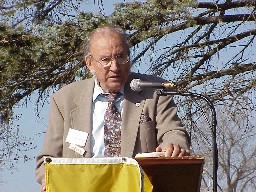 |
Dr. Philip E. Barnhart, NAAPO Coordinator, served as Master of
Ceremonies (MC). The Flag of Earth is draped across the podium, but the
wind quickly undid one side of the flag.
Phil is the Volunteer Coordinator of the North American
AstroPhysical Observatory, (NAAPO) which has overseen the operation
and maintenance of the radio observatory since 1985. He is Emeritus
Professor of Physics and Astronomy at Otterbein College in Westerville,
Ohio.
|
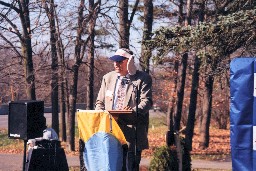 |
Phil Barnhart, later in the ceremony, talked about the 'Big Ear' radio
telescope. He put on an 'appliance' (show-biz talk for something applied
to a part of the actor's anatomy, in this case the face); Phil can be
somewhat of a 'ham' from time to time (I assume this comes about because
of him having been a Professor). This 'appliance' looks like a 'Big Ear'
(this is easier to see if you click on the photo to see a larger-size
version).
Here you can see the Flag of Earth better (yellow sun, blue earth, and
white moon on a black background).
|
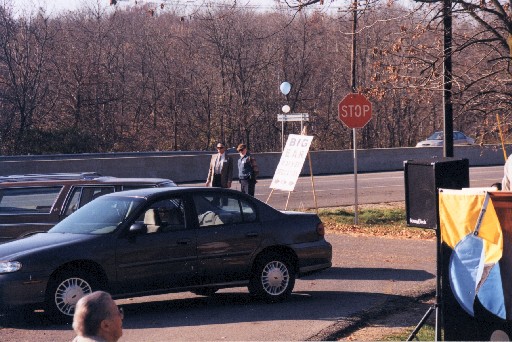 |
Two of our volunteers: Tom Hanson (on the left) and Ron Leeseberg (on the
right) assist folks coming into the Dedication Ceremony, by giving
directions for parking.
The Big Ear historical marker is located at the entrance to Dornoch Golf
Club, and the dedication ceremony was held near the marker.
|
 |
A good-sized crowd attended our Dedication Ceremony. There was local TV
coverage.
|
 |
Dr. Robert S. (Bob) Dixon, Associate Director of the Ohio State University
Radio Observatory (OSURO, also known as the Ohio State University Radio Observatory),
speaks to the audience. Bob Dixon was a student of Dr. Kraus and obtained
his Ph.D. degree in Electrical Engineering under Dr. Kraus. Bob created
innovative observational aids, particularly in analyzing the data of the
Ohio Sky Survey. Later, he conceived the ARGUS project.
To Bob's left is the Big Ear marker with an Ohio Bicentennial Commission
cover hiding the marker until near the end of the ceremony when the cover was
removed.
|
 |
Bob Dixon is shown closeup (zoom lenses are a wonderful invention!).
|
 |
Dr. Jerry R. Ehman shares his reminiscenses of the Big Ear radio telescope
and the accomplishments of Dr. John Kraus.
Jerry Ehman, obtained his Ph.D. degree in astronomy from the University of
Michigan where he specialized in radio astronomy. He was hired by John
Kraus in 1967. At the Ohio State University he taught courses in the
Department of Electrical Engineering half time and worked the other half
time as a radio astronomer at the Ohio State University Radio Observatory. While at the
Big Ear, he did some of the computer programming and was an observer
during the Ohio Sky Survey. Later he continued on as a volunteer to program
the computer and to analyze data from the Big Ear after the completion of
the Ohio Survey. He was the first person to notice the amazing narrowband
radio source, and he wrote the notation "Wow!" in the margin of the
computer printout. "Wow!" is now a very famous expletive (but an expletive
that can be voiced; there is no need for this expletive to be deleted).
|
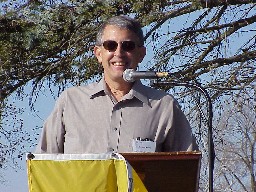 |
Dr. Jon Young, Director of OSU ElectroScience Laboratory (ESL). Jon used the
Big Ear as a compact range for radar studies. While he was conducting those
studies, our receivers needed to be turned off to prevent damage from the
strong radar transmitter signals.
|
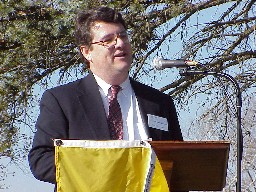 |
Dr. Steven W. (Steve) Ellingson started as a volunteer at the Big Ear
while in graduate school at OSU in Electrical Engineering. Currently
he is the principal investigator for our Argus radio telescope project (Argus
is considered the next generation of radio telescopes).
|
 |
Dr. Stephen (Steve) Brown served as a volunteer chief engineer at the Big
Ear until obtaining his Ph.D. degree while working on the Argus program. Both
his Masters and Ph.D. degrees dealt with the theoretical and computational
aspects of combining signals from individual elements (antennas) to form
multiple beams in the sky (Bob Dixon's Argus concept).
|
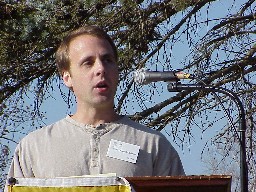 |
Russell (Russ) Childers was a volunteer who served as the chief observer
at Big Ear for many years during the 1980s - 1990s. He created coomputer
software to automate the observing program after the crash of the old
standby computer. He created a program to recognize celestial sources and
select narrow-band sources for closer scrutiny by the Big Ear.
|
 |
Mr. Philip Ross, Historical Markers Coordinator of the Ohio Historical
Society (OHS), provided much advice and help in arranging for the
production of this marker.
|
 |
Ms. Carmelita Boyer, Regional Coordinator of the Ohio Bicentennial
Commission (OBC), spoke about the OBC's participation in establishing this
marker and the purpose of the OBC in general.
|
 |
The blue cover of the Ohio Bicentennial Commission hides the marker,
temporarily. What will the marker look like when it's unveiled?
|
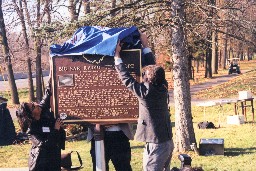 |
Ms. Carmelita Boyer, Regional Coordinator of the Ohio Bicentennial
Commission (on the left) and Philip Ross, Historical Markers Coordinator of
the Ohio Historical Society (on the right), unveil the Big Ear Historical
Marker. Phil Barnhart, behind the marker, is assisting in removing the cover.
|
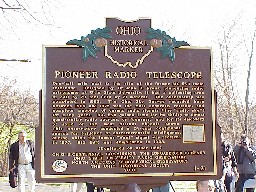 |
This shows Side 1 of the marker. Notice the number 1-21 in the lower
right corner. That refers to the fact that this marker was the first OHS
marker in Delaware County (county number 21 in an alphabetical list of
counties in Ohio). The small photo embedded within the text shows the
"Wow!" signal from the computer printout of August 15, 1977 revealing Dr.
Jerry Ehman's notation of astonishment when he noticed the signal. Look
below for a closeup photo of that portion of the marker.
The text on Side 1 of the marker reads as follows:
PIONEER RADIO TELESCOPE
One half-mile east is the site of the former BIG EAR radio telescope.
Designed by Dr. John D. Kraus, pioneering radio astronomer at Ohio
State University, it had a collecting area of 340 by 70 feet
(104 by 21 meters). The observatory was completed in 1963. The Ohio
Sky Survey recorded here between 1965 and 1972 was the most accurate,
reliable and complete mapping of cosmic radio signals (the radio sky)
for many years. Big Ear gained fame for its ability to detect
quasi-stellar radio sources, or "quasars," and for its discovery of
some of the most distant objects known. This observatory conducted
a 24-year continuous search for evidence of extraterrestrial
intelligence, during which the famous "Wow!" signal was received in 1977.
BIG EAR was demolished in 1998.
|
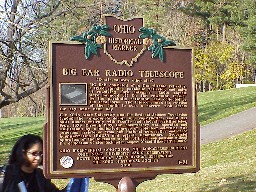 |
This shows Side 2 of the marker. The small photo embedded within the text
is an aerial photo of the Big Ear. Look below for a closeup photo of
that portion of the marker.
The text on Side 2 of the marker reads as follows:
BIG EAR RADIO TELESCOPE
BIG EAR consisted of a flat tiltable reflector, a fixed standing
parabolic reflector, and pairs of receiving horn antennas. Radio
signals were bounced off the flat reflector, focused by the parabolic
reflector, and collected by the feed horns. The telescope used the
rotation of the Earth to scan a narrow path across the sky once each day.
The Ohio State University and the National Science Foundation funded the
telescope's design and construction, and it was built almost entirely
with faculty and student part-time labor. From 1973 through 1997, the
observatory was operated and maintained by a dedicated group of
volunteer scientists with generous assistance from the National
Aeronautics and Space Administration (NASA) and private benefactors.
Successful operation of the telescope would not have been possible
without the dedication of site technician Eugene (Gene) Mikesell
(1931 - 1987).
|
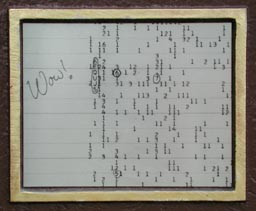 |
This is a graphic of a portion of the computer printout showing the famous
'Wow!' signal; it is reproduced on Side 1 of the Big Ear Historical Marker.
Dr. Jerry Ehman discovered this very strong narrowband radio source and
immediately wrote the notation 'Wow!' in the margin of the computer printout.
This radio signal arrived on August 15, 1977. It was seen only once even
though the radio astronomers at the Big Ear and others around the world
have conducted many searches for the source of the signal. Even now,
decades later, the source of this signal is still unknown.
|
 |
This is an aerial photograph of the Big Ear radio telescope; it is
reproduced on Side 2 of the Big Ear Historical Marker.
Dr. John D. Kraus, Director of the Ohio State University Radio Observatory,
having built previous radio telescopes including an array of 96 helixes,
designed and built this radio telescope; it was given the nickname of the
'Big Ear'. Construction was completed in 1963 and observations then began.
Bob Dixon obtained his Ph.D. degree under John Kraus, and later became an
Associate Director of the Radio Observatory.
|
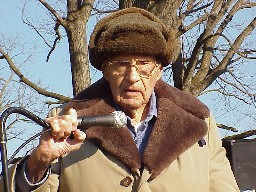 |
Dr. John D. Kraus, creator and builder of Big Ear, had indicated that he
didn't plan to make remarks at this Dedication Ceremony. However, after he
heard from all of the speakers and after the Big Ear Historical Marker was
revealed, John was moved to make some comments to the assembled crowd.
John Kraus is Ohio's first and foremost radio astronomer, designer and
builder of the Big Ear, the third largest radio telescope in the United
States. He is very well respected by those who worked with him at the Ohio
State University Radio Observatory and by radio and optical astronomers
world wide.
|
 |
Dr. John Kraus and Steve Brown are recalling the past after the unveiling
of the marker.
|
 |
Dr. John Kraus and his wife Alice (in the wheelchair) are sharing memories
with Bob Dixon.
|
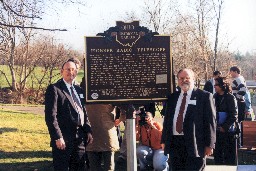 |
Jerry Ehman and Bob Dixon, long-time colleagues at the Big Ear Radio
Observatory, enjoy the moment.
|
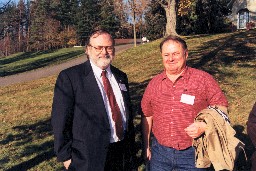 |
James Cadle (on the right), designer of the Flag of Earth, talks with
Bob Dixon.
|
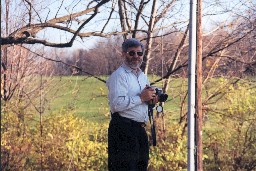 |
Dr. H. Paul Shuch, Executive Director of the SETI League, has been a good
friend of our group. Paul flew his private airplane from New Jersey to attend
the ceremony. Afterward, at the reception at Perkins Observatory, he sang
songs about Big Ear and the "Wow!" signal that he composed.
|
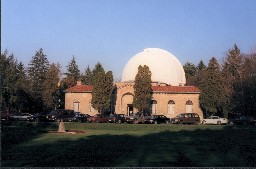 |
Following the Big Ear Historical Marker Dedication Ceremony, many in the
crowd walked or drove their cars the short distance to Perkins Observatory
where a reception was held (many thanks to Tom Burns, Director of Perkins
and to his staff for opening the observatory for this reception).
Paul Shuch, Executive Director of the SETI League, sang several of his
own songs about Big Ear and the "Wow!" signal.
|
![[Aerial Photo of Big Ear]](../bigearhp.gif)
![[Aerial Photo of Big Ear]](../bigearhp.gif)
![[NAAPO Logo]](../NAAPOsm.jpg)